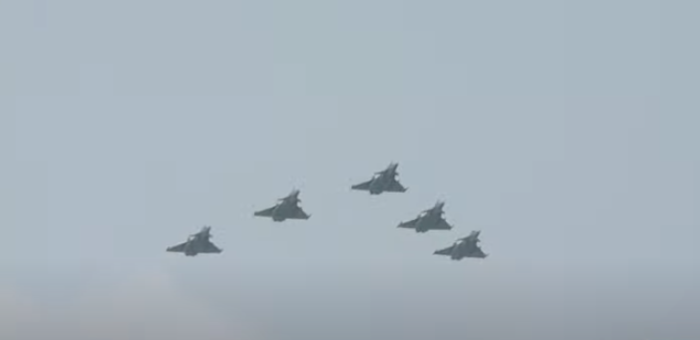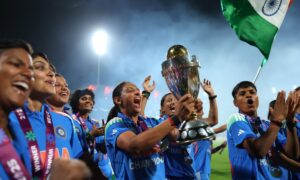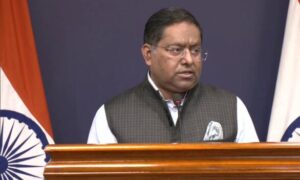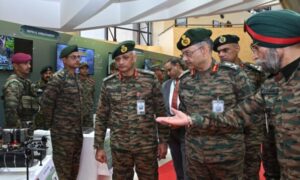
Picture : Twitter/ ANI
India celebrated its 73rd Republic Day with a impressive parade at the iconic newly laid Rajpath . Crowds at the Republic Day parade on were curtailed to just 5,000 people, all double masked, vaccinated and maintaining strict ‘do gaz ki doori’ in view of the Covid situation.
Only double vaccinated adults and children above the age of 15 who have taken at least one dose of a COVID-19 vaccine were allowed to enter the venue. Children below 15 years were not permitted to attend. There was strict security with personnel maintaining strict vigil.
Chairs were placed at a distance to ensure social distancing. Participants also received a white cap with “Azadi ka Amrit Mahotsav” printed on it. . As per tradition, the national flag was unfurled followed by the National Anthem with a booming 21-gun salute, presented by Ceremonial Battery of 871 Field Regiment.
The parade began with flypast by four Mi-17V5 helicopters of the 155 Helicopter Unit flying in a wineglass formation. The military power were on display with the – Detachments of Centurion Tank, PT-76, MBT Arjun MK-I, and APC Topaz, 75/24 Pack Howitzer MK-I indigenously developed gun system .
The tableaux of Arunachal Pradesh, Karnataka and Jammu & Kashmir at Rajpath during #RepublicDayParade pic.twitter.com/lwL7McGPT4
— ANI (@ANI) January 26, 2022
Tableaux of 12 States/Union Territories and nine Ministries/Departments, which have been prepared on various themes under ‘Azadi ka Amrit Mahotsav’ marched down Rajpath.
Tableau of UP showcases achievement through skill development &employment via ‘One District One Product’, based on new micro, small & medium enterprise policy & industrial development policy of the state govt. Development in Kashi Vishwanath corridor also exhibited.#RepublicDay pic.twitter.com/r2eUNtWZv0
— ANI (@ANI) January 26, 2022
Three marching contingents of the Indian Army wore uniforms and carried rifles from previous decades, while one contingent wore the new combat uniform and carried the latest Tavor rifles at Republic Day Parade-2022 (RDP-2022) as a part of ‘Azadi ka Amrit Mahotsav’ celebrating the 75th year of India’s independence.
There were a total of six marching contingents of the Army at the parade this year.
Each marching contingent this year comprised 96 soldiers instead of the usual 144 so that proper attention can be given to COVID-19 protocol.
The Indian Army’s first marching contingent, of Rajput regiment soldiers, wore the 1950s uniform and carry .303 rifles.
The second marching contingent, of Assam regiment soldiers, wore the 1960s uniform of the Indian Army and carry .303 rifles.
The 1970s uniform of the Army was worn by soldiers of the Jammu and Kashmir Light Infantry regiment, who formed the third marching contingent, and they carried 7.62 mm self-loading rifles.
The contingent of J&K Light Infantry (JAK LI), led by Maj Ritesh Tiwari of 5th Battalion of JAK LI, marches down the Rajpath.
The contingent is attired in the Indian Army Uniform of 1970s and carrying weapon 7.62mm SLR. #RepublicDay parade pic.twitter.com/F257jk0aBe
— ANI (@ANI) January 26, 2022
The fourth and fifth marching contingents were of Sikh Light Infantry and Army Ordnance Corps Regiment, respectively, and these soldiers wore the current uniform of the Army and carry 5.56 mm Insas rifles.
Parachute Regiment attired in the new combat uniform of the Indian Army and carrying weapon Tavor Assault rifles at the #RepublicDay parade pic.twitter.com/OFytkRjEew
— ANI (@ANI) January 26, 2022
The country’s first woman Rafale fighter jet pilot Shivangi Singh was part of the Indian Air Force tableau at the Republic Day parade on Wednesday. She is only the second woman fighter jet pilot to be part of the IAF tableau.
Last year, Flight Lieutenant Bhawna Kanth became the first female fighter jet pilot to be part of the IAF tableau.
Singh, who is from Varanasi, joined the IAF in 2017 and was commissioned in the IAF’s second batch of women fighter pilots. She had been flying MiG-21 Bison aircraft before flying the Rafale.
She is part of the IAF’s Golden Arrows squadron based out of Ambala in Punjab.
#RepublicDayParade | Indian Air Force tableau displays the theme ‘Indian Air Force Transforming for the future’. It showcases scaled-down models of MiG-21, Gnat, Light Combat Helicopter (LCH), Aslesha radar and Rafale aircraft. #RepublicDay pic.twitter.com/t1iaU7OsTX
— ANI (@ANI) January 26, 2022
The IAF tableau was based on the theme — ‘Indian Air Force transforming for the future’. Scaled down models of Rafale fighter jet, indigenously developed light combat helicopter (LCH) and 3D surveillance radar Aslesha MK-1 were part of the float.
It also featured a scaled down model of MiG-21 aircraft that played a major role in the 1971 war in which India defeated Pakistan, leading to the creation of Bangladesh, as well as a model of India’s first indigenously developed aircraft Gnat.
#WATCH Amrit formation comprising 17 Jaguar aircraft make a figure of 75 on #RepublicDay
(Source: Ministry of Defence) pic.twitter.com/caNQTnNHoK
— ANI (@ANI) January 26, 2022
The Grand finale of the Republic Day parade was the the fly-past with 75 aircraft of the Indian Air Force
[the_ad id=”41103″]


















